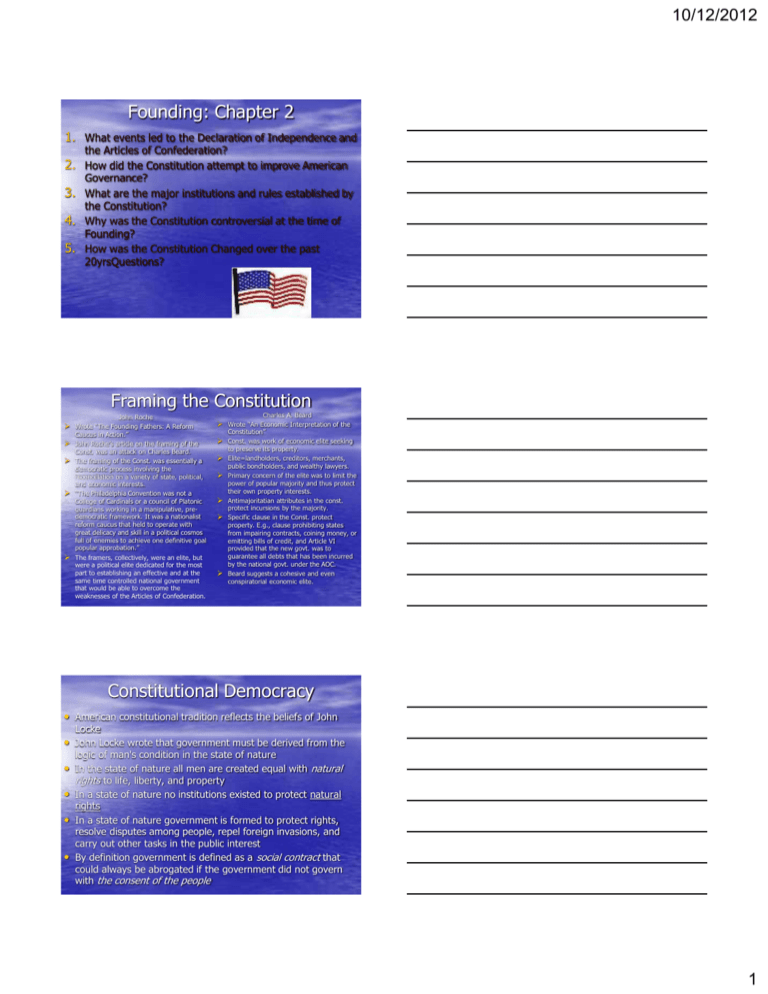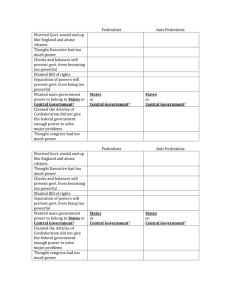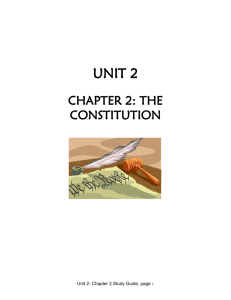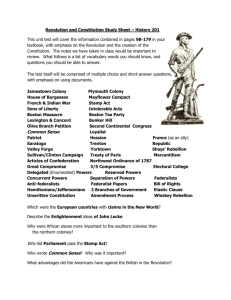Founding: Chapter 2 Framing the Constitution
advertisement

10/12/2012 Founding: Chapter 2 1. What events led to the Declaration of Independence and the Articles of Confederation? 2. How did the Constitution attempt to improve American Governance? 3. What are the major institutions and rules established by the Constitution? 4. Why was the Constitution controversial at the time of Founding? 5. How was the Constitution Changed over the past 20yrsQuestions? Framing the Constitution John Roche Charles A. Beard Wrote “The Founding Fathers: A Reform Wrote “An Economic Interpretation of the John Roche’s article on the framing of the The framing of the Const. was essentially a Caucus in Action.” Const. was an attack on Charles Beard. democratic process involving the reconciliation on a variety of state, political, and economic interests. “The Philadelphia Convention was not a College of Cardinals or a council of Platonic guardians working in a manipulative, predemocratic framework. It was a nationalist reform caucus that held to operate with great delicacy and skill in a political cosmos full of enemies to achieve one definitive goal popular approbation.” The framers, collectively, were an elite, but were a political elite dedicated for the most part to establishing an effective and at the same time controlled national government that would be able to overcome the weaknesses of the Articles of Confederation. Constitution” Const. was work of economic elite seeking to preserve its property. Elite=landholders, creditors, merchants, public bondholders, and wealthy lawyers. Primary concern of the elite was to limit the power of popular majority and thus protect their own property interests. Antimajoritatian attributes in the const. protect incursions by the majority. Specific clause in the Const. protect property. E.g., clause prohibiting states from impairing contracts, coining money, or emitting bills of credit, and Article VI provided that the new govt. was to guarantee all debts that has been incurred by the national govt. under the AOC. Beard suggests a cohesive and even conspiratorial economic elite. • Constitutional Democracy • American constitutional tradition reflects the beliefs of John Locke • John Locke wrote that government must be derived from the logic of man's condition in the state of nature • In the state of nature all men are created equal with natural rights to life, liberty, and property • In a state of nature no institutions existed to protect natural rights • In a state of nature government is formed to protect rights, resolve disputes among people, repel foreign invasions, and carry out other tasks in the public interest • By definition government is defined as a social contract that could always be abrogated if the government did not govern with the consent of the people 1 10/12/2012 The First Founding: Interests and Conflicts • The American Revolution and the American • 1. 2. 3. 4. 5. • Constitution were the results of a struggle among economic interests and political forces in the colonies. The 5 sectors with important political interest struggles were: The New England Merchants The Southern Planters The Royalists Small farmers Shopkeepers, artisans, and laborers British taxes affected all these groups and set the Revolution in motion. First Founding, Cont… British Taxes and Colonial Interests • In the 1760s, British financial and debt problems led • • • the British govt. to impose new taxes on colonies, such as the Stamp Act, the Sugar Act, and other tariffs on commerce These taxes caused social unrest among the colonists. Merchants and planters who generally supported the British rule united with shopkeepers and small farmers to oppose taxes Once repealed the merchants and planters would have returned to the status quo ante, but shopkeepers and farmers pushed for radical reform and ultimately, a break from British rule First Founding, Cont… Political Strife and the Radicalizing of the Colonists • Merchants and planters again partnered with more radical elements to protest the Tea Act of 1773 • The Teat Act granted the East India company monopoly to export tea from Britain • This movement ended in the Boston Tea Party, which prompted a series of retaliatory actions by the British • Cycles of provocation and retaliations resulted in the First Continental Congress 2 10/12/2012 First Founding, Cont… The Declaration of Independence • In 1776, the Declaration of Independence, written by Thomas Jefferson was adopted by the Second Continental congress • It asserted that “unalienable rights”—including life, liberty, and the pursuit of happiness—could not be denied by government • The declaration attempted to identify and articulate principles that united the diverse interests of the colonials and that might form the basis for national unity First Founding, Cont… The Articles of Confederation • 1n 1777, having declared independence, the CC • • • • adopted the Articles of Confederation and Perpetual Union The Articles of Confederation was the first written constitution and basis for the U.S. national govt. until 1789 The model of government was confederation (states retained authority except for the powers expressly delegated to the national govt.) Weak Unicameral Congress Execution of laws was left to the individual states The Second Founding: From Compromise to Constitution • Congressional powers under the Articles of • • • • Confederation were insufficient to maintain the unity of the new nation International Standing and Balance of Power Under the AOC, Congress was unable to enforce treaties unless the states agree to them Made the government illegitimate to other nations and vulnerable to threats from them States competed with one another for economic advantage, giving other nation leverage to take advantage of the states Domestically, radical elements mobilized threatening people’s security and property rights 3 10/12/2012 Second Founding, Cont.. The Annapolis Convention • Constant weakness and domestic turmoil led Americans to revise the confederated govt. • In the fall of 1786, the Annapolis Convention brought together delegates from several states and resolved that commissioners be sent to Philadelphia to devise a constitutional revision that would meet the needs of the union • Commissioners from 5 states (NY, NJ, PA, DE, & VA) called for a general convention at Philadelphia in May 1787. Key Features of the AOF • A unicameral legislature with only one house of the Congress in command • No provision for a full fledged judicial system, thus no branches of judiciary in various states • No executive branch of the government, (and hence no president). • One vote per state irrespective of the size of the state • A majority of 2/3 for passing any legislation • A unanimous vote for amendment of the Articles of Confederation • No provision for national government interference in commerce and trade • Provisions for levying taxes in hands of the state government, and not the government at the center Second Founding, Cont… The Constitutionals Convention • The delegates convened to revise the AOC in Philadelphia in May 1787 • Delegates wanted to address the flaws of the AOF • Abandon the plans of revising, and attempt to create a new, legitimate govt. • The textbook refers to this decision as the start of “second founding.” 4 10/12/2012 Second Founding, Cont… A Marriage of Interests and Principle • The framers’ economic interests were reinforced by their philosophical and ethical principles • They sought to create a constitution that: promote commerce and protect property Prevent excessive democracy Bicameralism Checks and balances Electoral college has popular support Popular elections Prevent govt from abusing its power Federalism Separation of powers Second Founding, Cont… The Great Compromise • During the CC, a division between the large and small states threatened to destroy the nation • Edmund Randolph of Virginia introduced the Virginia plan—calling for representation in the national legislature on the basis of each state’s population • Smaller states vehemently opposed the Virginia plan and introduced an alternative—New Jersey plan Second Founding , Cont.. • New Jersey plan—called for equal state representation in the national legislature regardless of population • The debate between the two sides ended in the Connecticut compromise, also known as the Great Compromise • Congress would comprise two houses organized as follows: (1) one branch, the House of Representatives would be apportioned according to the population of each state, and (2) the Senate, each state would have an equal vote regardless of size. 5 10/12/2012 Second Founding, Cont… The question of Slavery: The Three-fifth Compromise • Slavery was a very controversial issue • Slavery made it clear that the division among states was not about size but also geography • The conflict was between the North (non-slave- holding states) and the South (slave-holding state) • The question was whether to count salves as part of the population for representation purposes • The 2 sides reached 3/5 Compromise, by which every slave would be counted as 3/5 of a person 3/5 Compromise • Regulation of Slavery Southern states were afraid that Northern states would ban importation of slaves and possibly even outlaw slavery As a compromise, importation of slavery remained in effect for at least 20 years after the institution of the new constitution The three-fifths compromise remained in effect until the end of the Civil War After the civil war, the 13th Amendment was passed and made all former slaves citizens Constitution Principles 1. Bicameralism—the division of congress into two houses, or chambers 2. Checks and balances—the mechanism through which each branch of government is able to participate in and influence the activities of the other branches 3. Electoral College—selection of the president by electors (rather than directly by voters) from each state who meet after the popular election to cast ballots for the president and VP. 6 10/12/2012 The Constitution 4. Bill of Rights—the first ten amendments to the U.S constitution, ratified in 1791 The Bill of Rights ensure certain rights and liberties to the people 5. Separation of Powers—the division of governmental power among several institution that must cooperate in decision making 6. Federalism—a governmental system in which power is divided by a constitution between central and regional govt The Legislative Branch • Article 1 provided for a Congress made up of 2 houses • The House of Representatives are directly elected by the people for 2yr-terms • The Senate is appointed by state legislatures for 6yr• • terms—staggered so that only 1/3 of the Senate changes in any given election Express congressional powers include collecting taxes, borrowing money, regulating commerce, declaring war, and maintaining an army and navy Article 1 also contains the “necessary and proper” clause, which acts as a vehicle to expand legislative power beyond those expressed in the constitution The Executive Branch • Article II establishes a presidency. • Framers wanted an energetic executive capable of timely action to deal with public problems • They also wanted a moderately independent executive insulated from direct voter election. • The president’s term is limited to two four year terms. • The president was given powers to: recognize other countries, negotiate treaties, grant reprieves and pardons (http://www.justice.gov/pardon/statistics.htm) convene Congress in special sessions, and veto congressional enactments. 7 10/12/2012 The Judicial Branch • Article III creates the judicial branch. • Under Article III, Supreme Court justices are appointed to life terms by the president with the approval of the senate • The SC’s powers include: resolving conflicts between federal and state laws determining whether the powers belong to the national government or the states, and settling controversies between citizens of different states • Constitution does not mention of Judicial Review— the power of the courts to declare actions of the legislature and executive branches unconstitutional National Unity and Peace • Article IV establishes reciprocity among states • Each state must give “full faith and credit” to official acts of other states • Each state must guarantee the citizens of any state the “privileges and immunities” of every state • Article VI institutes national supremacy with the supremacy clause • Supremacy clause states that laws passed by the national govt and all treaties are the supreme law of the land and superior to all laws adopted by any state or subdivision. E,g. DOMA--Section 2: “No State …shall be required to give effect to any public act, record, or judicial proceeding of any other State…respecting a relationship between persons of the same sex that is treated as a marriage under the laws of such other State…or a right or claim arising from such relationship.” Amending the Constitution • Amending the constitution is not easy. • Since its promulgation only 27 amendments have been passed • Proposal must be put forth by either 2/3 of both chambers of Congress or a convention called by 2/3 of the legislature. • Amendments must be ratified by either the legislature or the state convention of 3/4 of the states. 8 10/12/2012 Constitutional Limits on the National Government’s Power • The framers wanted a powerful govt with safeguards against misuse of that power • So, they included 3 limitations in the constitution. 1. Separation of powers 2. Federalism, and 3. Bill of Rights Separation of Powers • Power must be used to balance power • The entire structure of national govt is built on 3 separate branches: Legislature, executive and judiciary. Federalism • The delegates devised a system of two sovereign power—the states and the nation • Sovereign system was to limit the power of the states and national government Bill of Rights • The first 10 amendments to the constitution. • Adopted shortly after ratification of the constitution • Limit national power and protect citizens The Fight for Ratification • Ratification was the first hurdle to the constitution • Federalists and Anti-federalist • Federalists favored a strong national govt • Federalist supported and proposed the American Constitution at the 1787 convention • Anti-federalists favored strong state govt and a weak national govt • Anti-federalists opposed the proposed American Constitution at the 1787 convention 9 10/12/2012 Federalists vs. Anti-federalists • Used essays, speeches, pamphlets and letters to support and oppose the constitution • Federalist papers are the best constitutional support • Both sides had difference of opinions on certain issues 1. Representation • Anti-federalists asserted that representatives must be “a true picture of the people.” • Anti-federalists favored more direct democracy, which would not be possible in a large nation • Federalists—representatives shouldn’t be exactly like those they represent • Representative democracy=better representatives The Fight for Ratification, Cont… 2. Tyranny of the Majority • Threat of tyranny—oppressive rule and unjust govt that employs cruel and unjust power and authority • Anti-federalists feared the danger of the few to oppress the many • Anti-federalists feared the concentration of power in • the hands of a small governing elite (oligarchy/ aristocracy) Federalists argued that the danger was not in aristocracy, but in tyranny by the majority driven by common impulse of passion, or of interest adverse to the rights of other citizens.) • The Fight for Ratification, Cont… 3. Governmental Power • Both sides agreed on limited govt. (a govt. whose powers are defined and limited to a constitution) • They deferred on how to place limits in govt. action • Anti- federalists sought to enumerate the national powers in relation to the states and the people • Anti-federalists attached the supremacy and elastic clause because it granted dangerous amount of power to the national govt • Federalists favored a national govt. with broad powers capable to protecting and providing for the welfare of the people and states • Federalist were aware of power abuse, but they felt the internal checks and balance deter the abuse. 10 10/12/2012 Federalists vs. Antifederalists Federalist Antifederalists Who were they ? Property owners, creditors, merchants Small farmers, frontiersmen, debtors, shopkeepers What did they believe Believed that elites were best fit to govern; feared “excessive democracy” Believed that government should be closer to the people; feared concentration of power in the hands of the elites What system of government did they favor? Favored strong national government; believed in “filtration” so that only elites would obtain governmental power Favored retention of power by state governments and protection of individual rights Who were their leaders? Alexander Hamilton, James Madison, George Washington Patrick henry, George Mason, Elbridge Gerry, George Clinton Ackerman Erin and Ginsberg Benjamin, Guide to the United States Constitution, 2nd ed., New York: Norton,2011. Reflection on the Founding • It was largely the federalist point of view that triumphed • Anti-federalists criticism forced the adoption of a Bill of Rights to limit national govt. power • The arrangement has been proved effective for over 200yrs • The political principle enshrined in the constitution has benefitted groups and interests unforeseen by the framers (especially minority groups) The Citizen’s Role and the Changing Constitution • The constitution has endured for over 200yrs, but not without change Amendments: Many are Proposed, Few are Passed • 4 ways to amend the constitution (Fig. 2.3) • 2 are commonly used as follows: Passage in House and Senate, each by 2/3 vote Ratification by ¾ of the states’ legislatures OR Passage in the House and Senate, each by 2/3 vote Ratification by ¾ of the states’ conventions (used only once to repeal Prohibition) 11 10/12/2012 Interpreting the Constitution • The Const. is only a framework, it is not a blue print. • • E.g., the 8th Amend prohibits the infliction of “cruel and unusual punishment” but gives no examples of permissible or impermissible punishments; the 14 th Amend proscribes states abridgement of the ”privileges or immunities of the citizens of the United States,” but contains no catalog of privileges or immunities. Even the framers interpreted the Const in different ways. McCulloch v. Maryland (1819) The debate of whether the Const. should be read “strictly” or “loosely” has changed into another debate over the importance of ”original intent” Interpreting the Constitution • If the Const. is simply a framework, how do we find concrete authority? • Judges interpreting the Const. have the same text, and the text has one history however complex, however multifaceted. • But different people believe different things about how history bears on the enterprise of the Const. interpretation. • People approach the Cont. with different visions, different premises and different convictions. E.g., “I would hope that a wise Latina woman with the richness of her experiences would more often than not reach a better conclusion than a white male who hasn’t lived that life.” Sonia Sotomayor • Is the Const. simply a mirror in which one sees what one wants to see? Questions for Discussion • Describe the ways in which the framers limited the national govt’s power under the constitution. Why might the framers place such limits on the govt they had just created? • What were the major points of contention between the Federalists and Anti-federalists? Do you think you would have sided with the Federalists or with the Anti-federalists? Why? • The framers of the Constitution were very concerned with creating an effective system of govt. Yet whenever crises loom critics charge that the U.S. govt. is too cumbersome and too filled with checks and balances to promote effective action. Does the war on terrorism reveal our constitutional govt’s effectiveness or lack of it? Are there ways in which we benefit from govt’s occasional lack of efficiency? 12 10/12/2012 Writing Assignment As the text notes, many amendments to the Constitution have been proposed, but only a few have been successful. 1. Identify a proposed, amendment that failed. 2. What was its purpose? 3. Who proposed it and who supported it? 4. Why didn't it pass? 5. How far it go—e.g., passed congress, but failed at the state level. 6. Would you have supported or not supported this amendment? Why? 13









